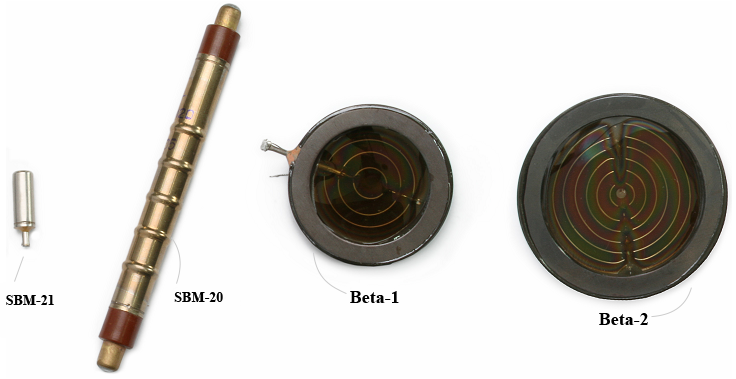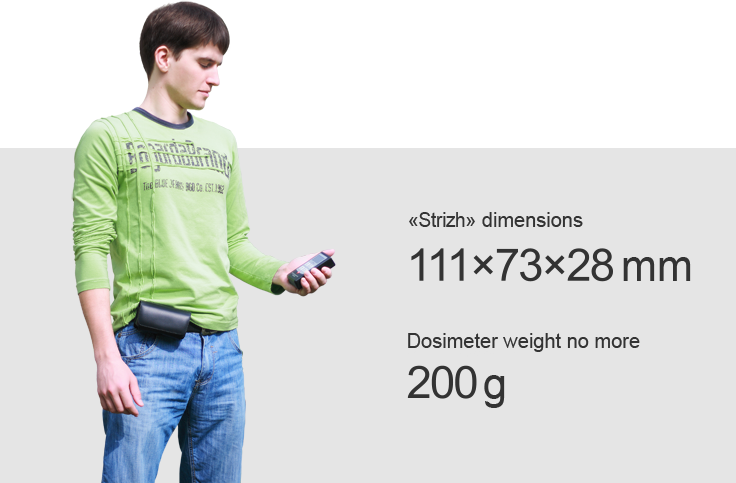Main questions
What is the danger of radiation?
All substances consist of tiny particles called atoms and molecules which cannot be seen with the naked eye. Atoms in fact are very solid systems. Even intensive effects (e.g. heating, pressure change, etc.) lead only to insignificant changes of the atoms. However, some atoms are unstable (they are often called radionuclides), they spontaneously decay and turn into the different ones. There are three main types of spontaneous nuclear transformations.
- Alpha decay. The nucleus emits an alpha particle, which is a helium nucleus consisting of two protons and two neutrons. Alpha radiation can be stopped by a piece of paper and is virtually unable to penetrate the outermost skin layer. It is not dangerous as long as the radioactive substances that emit alpha particles do not get inside the body through an open wound or with food or inhaled with air. Once inside the body, alpha particles become extremely dangerous.
- Beta decay. In an unstable nucleus neutron transforms into a proton, and the nucleus emits an electron (beta particle). Beta radiation has a high penetrating power: it gets as deep into body tissues as 1-2 cm. It can cause radiation skin burns and lead to radiation poisoning (radiation sickness). As in case of alpha radiation, internal exposure to beta-active radionuclides is extremely dangerous.
- Gamma decay. Nucleus in an excited state emits electromagnetic radiation of very short wavelength and very high frequency. Penetration power of gamma radiation (which travels in a vacuum with the speed of light) is very high – it can be stopped only with a thick lead or concrete slab.
The energy of radiation penetrating into a living organism leads to disruption of chemical bonds in cells, and causes the formation of chemically highly active compounds – so-called free radicals. As a result, body starts to undergo different chemical transformations (which are no longer nuclear). The greater the amount of the radiation absorbed by body tissues, the greater the damage is.
What is a personal dosimeter?
Dosimeter — is a device measuring exposure rate and dose of the ionizing radiation.
Absorbed dose(also known as total ionizing dose, TID) is the basic physical quantity adopted in dosimetry to assess measures of ionizing radiation. The dose of radiation is an absorbed radiation energy calculated per unit mass of an irradiated material. It is a quantitative characteristic of the result of interaction between radiation and matter.
Equivalent dose of ionizing radiation is calculated by multiplying the absorbed dose with the average quality factor of ionizing radiation in a specific volume of tissue of standard composition. The unit of measurement in the SI system is Sievert (Sv).
Exposure dose — is a specific quantity in dosimetry introduced for use with the photon radiation. It equals the absolute value of the full charge of the ions of the same sign, which are formed in the air under complete deceleration of electrons and positrons released by photons in the unit of air mass. Common unit of measurement is Roentgen (R). Use of Roentgen units has recently been prohibited.
Dose (or dose rate) — is accumulated value of the radiation for a fixed period of time. Measured in units of the corresponding type of radiation divided by the unit of time – usually it is 1 hour.
Radiometer measures the density of radiant flux (power) of radiation (particles), and is usually used to control the surface contamination for alpha and beta emitting nuclides. These devices measure the number of particles crossing the detecting surface per time unit (unit of measurements is particles/cm2·min).
Personal dosimeter-radiometer
It is easy to figure out that the dosimeter-radiometer combines the functionality of both dosimeter and radiometer. Personal dosimeters-radiometers, as a rule, allow to detect and to measure beta and gamma radiation with sufficient effectiveness.
Readings of personal dosimeters-radiometers can be displayed as follows:
- when measuring the dose — either in units of the equivalent dose or exposure dose. In other words, measured value of a dose is indicated by Sievert (Sv) or Roentgen (R);
- when measuring a dose rate — either in units of the equivalent dose rate or exposure dose rate (i.e. measured value of dose is indicated by Sv/h or R/h);
- when measuring a radiant flux density — in particles/(cm2·min).
Numerical values of the measurement results of equivalent dose and exposure dose differ by about a hundred times. In other words, readings of the equivalent dose of 1 Sv would be consistent with the measurement result of the exposure dose app. equal to 100 R. Accordingly, readings of the equivalent dose rate of 1 Sv/h would be consistent with the result of measurement of exposure dose rate equal approximately to 100 R/h. The following information could help in understanding the value and scale limits of dose rates and surface contamination:
- value of the natural background radiation varies from 0,1 uSv/h to 0,15 uSv/h (10 – 15 uR/h).
- in a survey of a potential construction site, values of the equivalent gamma radiation dose rate should not exceed the following: 0,3 uSv/h for control points, and 0,2 uSv/h for the arithmetic mean value.
- beta particles surface contamination is detected when the flux density of beta radiation exceeds 24 particles/(cm2·min) around some areas on the surface of the object being examined.
Types of the radiation detectors used
Radiation detector is an essential structural element of dosimeter, largely determining its specifications. Detector registers the external radiation and for each event (registration of gamma-ray, alpha, beta particles) generates an electrical signal (pulse). Currently there are few detectors used in the constructions of dosimeters. Most of the produced dosimeters are based on radiation detectors listed in Table 1.
Detector’s sensitivity defines the minimum amount of time for performing a measurement, and the possibility of solving various surveying tasks with the specific device. Omitting numbers, the statistic conclusion is that measurement with 50% uncertainty is achieved after the dosimeter registers at least 16 events. Measurement with 20% uncertainty is possible after the dosimeter records at least 100 events. Using the level of natural background radiation (0,10 uSv/h) and the detectors sensitivity data from Table 1 it is easy to calculate the necessary duration of measurement (Table 2).
Data in Table 1 point out the following:
- the duration of the performed measurement highly depends on the type of the dosimeter detector;
- dosimeters based on the SBM-21 and SBM-20 detectors can be considered as ones, operating within the natural background radiation with the significant degree of uncertainty;
- none of the dosimeters can be used in surveying - readings of a personal dosimeter in motion cannot be interpreted (!).
Table 1 and Table 2 show quality advantages of the Beta-1 and Beta-2 detectors over
Besides the MKS-03D «Strizh» dosimeter there is currently one more known dosimeter based on the Beta detector – DKG-07D "Drozd" (NPP «Dosa», Russia).
Dosimeter-radiometer: professional or consumer grade?
We should take a note here — we haven’t yet met any standards mentioning a class of so-called «professional» devices. But definitely there is a class of appliances which have an additional letter «b» in their names (in Ukrainian definitions — «p», «бытовой», «побутовий», «for domestic use»). Technical characteristics of these types of devices are special. That’s why it will be emphasized when necessary that it is a full-fledged (without an additional letter «b») measuring device being written about.
What are the «special» qualities of a personal dosimeter-radiometer? In particular these are:
- narrower energy range of the registered radiation;
- narrower range for the radiation rate measurements;
- higher calculation error rate;
- low sensitivity to the registered radiation.
To avoid overloading a non-professional user with unnecessary explanations of unfamiliar terms we better speak about possible consequences of such «differences». Duration of the consumer grade dosimeter measurements should be longer, sometimes up to ten minutes, but even after that it is impossible to interpret readings with certainty. Additionally, one fails to assess the quality of measurements because cheap models are often equipped with ancient displays which manage to represent the readings in only few symbols. This is the reason why manufacturers of consumer grade dosimeters-radiometers often intentionally hold back such quality characteristic as uncertainty of measurement (see below).
In other words, we have gradually come to questions about when readings can be trusted, what kinds of measurements can be made by a personal dosimeter-radiometer and...
How to make measurements?
Making measurements with radiometric and dosimetric equipment is not really complicated methodologically but it is quite unusual for a regular user to understand because it significantly differs from, for example, customary length or weight. It is not enough to just place the device around an object that needs to be examined. You have to wait long enough and then to interpret readings correctly. But how long to wait to have enough? How does one make the measurements with dosimeters-radiometers?
To obtain a true to life reading value:
- stand at a supposed survey spot;
- using the dosimeter-radiometer keyboard, start a new measurement;
- measure until the desired uncertainty degree is achieved;
- if necessary, carry out a series of repetitive measurements and calculate the average.
What rate of uncertainty can be considered satisfactory? In each case it is up to the user. However, it is common to hold the measurements until at least a 20% uncertainty is achieved. For instance, when controlling soil contamination of a site, the value of 0,3 µSv/h of gamma-ray background is acceptable. In this case, readings of 0,2 µSv/h with 10% uncertainty can be considered satisfactory.
All the requirements listed above suppose a dosimeter-radiometer to possess the following obligatory characteristics:
- displaying the measurement uncertainty rate;
- possibility to restart the measurement;
- calculation algorithm, embedded in the specific device, should allow a user to achieve the desired uncertainty rate.
It is not always easy to determine if this last requirement is fulfilled in one particular dosimeter-radiometer, and talks about properties and qualities of measurements calculation algorithms can make up the whole another discussion. But we can state with certainty that qualities of the described below MKS-03D «Strizh» dosimeter-radiometer satisfy all the requirements mentioned before.



